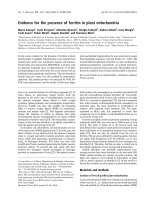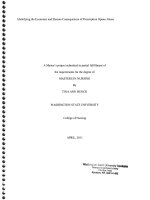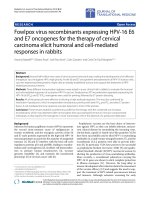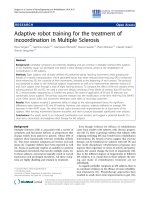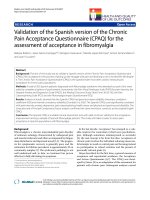Bioanalytical strategies for the quantification of xenobiotics in biological fluids and tissues 6
Bạn đang xem bản rút gọn của tài liệu. Xem và tải ngay bản đầy đủ của tài liệu tại đây (648.75 KB, 21 trang )
Chapter 6
112
Chapter 6 Investigation of bioaccumulation profile of
estrogens in zebra fish liver by hollow fibre protected liquid
phase micro-extraction with gas chromatography-mass
spectrometric detection
Chapter 6
113
6.1 Preface to chapter 6
The applicability of hollow fibre protected liquid phase microextraction
(HF-LPME) for the determination of three estrogens, namely estrone , 17 β-estradiol
and 17 α-ethinylestradiol from individual zebrafish liver samples, in a
bioaccumulation study on these organisms, is reported. The estrogens were extracted
from single, mechanically crushed and minced livers from fish that were heaved in
tubes containing water spiked at low concentration of the analytes. Extraction was
performed with ∼3 µL of toluene contained in the hollow fibre. In order to achieve
high extraction efficiency, the parameters that could affect the effectiveness of HF-
LPME were optimized, i.e. the extracting organic solvent, extraction time, stirring
speed and pH of the aqueous phase. For GC-MS analysis, injection port derivatization
of the estrogens with bis(trimethylsilyl)trifluoroacetamide was conducted. Under the
most favourable extraction and derivatization conditions, enrichment factors of 158 to
279 were obtained. Linearity of the HF-LPME-GC-MS method was evaluated from 1
to 50 µg L
-1
and the coefficient of determination (r
2
) ranged from 0.9687 to 0.9926.
The LODs were between 0.017 and 0.033 µg L
-1
(at a signal to noise ratio of 3) with
relative standard deviations (analytes spiked at 5 µg L
-1
) of between 15 and 17% (n =
3). The method was successfully proved to be capable of predicting the
bioaccumulation pattern on zebrafish and thus can be applied to similar study on
humans since zebrafish genome is a good model to study human genetics.
Chapter 6
114
6.2 Introduction
The release of endocrine disrupting compounds into the aquatic
environment has been a serious threat to organisms [1, 2]. These compounds interfere
with the endocrine system of the aquatic organisms and cause undesirable
physiological changes to them. One class of these endocrine disrupting compounds
consist of the hormone estrogens such as estrone (E1), 17 β-estradiol (E2), estriol
(E3), diethylstilbestrol (DES) and 17 α-ethinylestradiol (EE2). EE2 is a synthetic
estrogen used frequently in pharmaceutical products such as birth control pills as well
as in hormone replacement therapy for women [3, 4]. Thus, women who are on such
medication may excrete this synthetic estrogen together with the other naturally
occurring estrogens. These excreted estrogens may accumulate in aquatic organisms
living in such polluted environments and these can extend devastating effects on these
organisms [5-7].
Estrogens are female sex hormones whose structures bear the polycyclic
steroid structure and are known to cause abnormalities in reproduction of wildlife,
particularly feminization of male fishes [8]. In the case of zebrafish (Danio rerio), the
protein expression of male zebrafish is altered due to the presence of estrogens [9].
Zebrafish are increasingly being used to study the effects of chemicals and
pharmaceuticals in the environment [10, 11]. Male and female zebrafish are sensitive
to low concentrations of waterborne estrogens. Since the zebrafish genome resembles
that of human the prediction of rate of accumulation of estrogens in zebrafish can
reveal the effects of xenobiotic estrogens on humans [12]. There is a direct correlation
between the rate of bioaccumulation of estrogen in zebrafish and the extent of
xenobiotics estrogenic effects such as vitellogenin (VTG) induction and physiological
Chapter 6
115
changes in this species [13]. Earlier studies on fishes exposed to xenoestrogens mainly
dealt with the quantification of VTG concentration and its effects on fish. Hence there
is a need for a rapid analytical technique to estimate the bioaccumulation and hence
its subsequent effects on fish that has undergone estrogenic exposure. The objective of
the current study was to establish a sensitive microextraction technique to quantify the
bioaccumulated estrogens with low exposure concentration. This estimation of
accumulated estrogens along with a further study on induced VTG and its effects will
provide a clear depiction of xenoestrogenic effects on fishes. Moreover zebrafish is a
wonderful model for studying development and genetics of vertebrates, including
humans. In this regard, we intended to develop a simple analytical method to
determine the bioaccumulation of estrogens in zebrafish liver. Estrogens are present in
micrograms to sub-micrograms per litre levels in the aquatic environment [6, 14] and
the bioaccumulation factor in the fish could be much less; therefore, an effective and
fast extraction method is needed for the estrogens.
Traditional methods of extraction such as LLE and SPE uses moderate to large
volume of organic solvents, after which the extracts have to undergo further pre-
concentration prior to analysis. In recent years, LPME has been used for the extraction
of a variety of organic compounds such as alkylphenols [15] phthalate esters [16] and
pesticides [17]. Various modes of LPME have been developed such as single drop
microextraction (SDME) [18-21]. Headspace SDME [22, 23] has been used mainly
for the more volatile organic compounds. Although high enrichment factors can be
achieved using SDME, the single drop of organic solvent is potentially unstable and
may be easily dislodged from the syringe needle during the extraction process.
Polymer coated hollow fibre LPME [24], another variant of LPME, makes use of the
Chapter 6
116
affinity of certain analytes to some polymers used as sorbents. Another LPME mode,
hollow fibre protected (HF-LPME) represents a simultaneous extraction, cleanup and
pre-concentration approach [25-28]. The organic solvent used for extraction is
protected by the hollow fibre. In this work, for the first time, HF-LPME has been
developed for single zebrafish liver. Naturally occurring estrogens, estrone (E1) and
17β-estradiol (E2), and the synthetic estrogen 17α-ethinylestradiol (EE2)
bioaccumulation on zebrafish were investigated. Estrogens, being steroidal
compounds, are non-volatile and thus not suitable for direct GC-MS analysis. Hence,
derivatization of the estrogens was needed, after extraction with HF-LPME. The
conventional offline derivatization was not a feasible choice as the organic extract
volume using HF-LPME was very small (3 µL). Therefore for the first time with
estrogens, we made an attempt to carryout derivatization conducted in the injection
port of the GC-MS system after extraction.
6.3 Experimental
6.3.1 Chemicals and materials
HPLC-grade methanol, n-hexane, dichloromethane were purchased from
Tedia Company and ethyl acetate was from Riedel-DeHaen AG (Seelze-Hannover,
Germany). Toluene was purchased from Fisher Scientific. Derivatization reagent,
bis(trimethylsilyl)trifluoroacetamide (BSTFA), hydrochloric acid and sodium
hydroxide were purchased from Merck. The high purity standards (99%) of estrone,
17β-estradiol and 17α-ethinylestradiol were from Sigma Chemical. Ultrapure water
was prepared on a Nanopure water purification system (Barnstead, Dubuque, IA,
USA). Q3/2 Accurel polypropylene hollow fibre membrane with an inner diameter of
600 µm, wall thickness of 200 µm and wall pore size of 0.2 µm was purchased from
Chapter 6
117
Membrana (Wuppertal, Germany). A 10 µL GC syringe, with cone-shaped needle tip,
from SGE (Sydney, Australia) was used for manual sample injection into the GC-MS
system. Stock standard solutions were prepared in methanol at 1000 mg L
-1
of each
analyte and working standards were prepared by spiking appropriate volume of the
stock solution with methanol.
6.3.2 Hollow fibre-liquid phase microextraction
Hollow fibres were cut into 1.2 cm segments for HF-LPME. The
approximate internal volume of such a 1.2 cm segment was 3 µL. The 10 µL GC
syringe was rinsed with methanol and the organic solvent used for extraction before
being set up for the next extraction process. Approximately 3 µL of organic solvent
was withdrawn into the GC syringe and the needle of the syringe was inserted into
hollow fibre to about 0.2 cm of the tip of the syringe needle was covered by it. The
hollow fibre was then dipped into the organic solvent for 10 s to impregnate its pores.
The entire hollow fibre-syringe assembly was clamped on a retort stand, with the
hollow fibre immersed in 1.5 mL of the aqueous sample phase contained in a 2 mL
vial. The organic solvent in the GC syringe was released into the channel of the
hollow fibre after which the stir bar in the aqueous phase was activated and at the
same time, the stopwatch was started to measure extraction time. After extraction, the
stirring was stopped, and the organic solvent, was retracted into the GC syringe. The
hollow fibre was removed, and the organic extract in the syringe was adjusted to 2 µL
(the rest was discarded). Using the same syringe, 2 µL of BSTFA was withdrawn,
making the total volume in the GC syringe 4 µL. The entire 4 µL was injected into the
GC-MS for injection port derivatiztion and analysis.
Chapter 6
118
6.3.3 Experimental animals
Zebrafish were bisected at Ngee Ann Polytechnic, School of Life Sciences &
Chemical Technology, as part of the project collaboration. Approximately four
hundred adult zebrafish were received from the local market and male zebrafish were
separated from female fish by visual observation. Male zebrafish were maintained in
40 L glass aquaria with 40 fishes per tank. Each aquarium was individually heated
using a 100 W aquarium heater to maintain a temperature of 26 to 29.8ºC. Fish were
kept in filtered tap water, which was purified with activated charcoal and aerated.
Aeration and filtration were provided using sponge filters. Tanks were fed with a flow
through system that provided 1 L h
-1
of carbon filtered, and dechlorinated water. Fish
were fed a diet of Aquatox flake food (Aquatic Ecosystems, Apopka, FL, USA) in the
morning and in the evening. Fish were maintained on a photoperiod of 16 h light:8 h
dark. The pH ranged from 7.0 to 7.6 throughout the duration of the experiment, and
ammonia concentrations were non-detectable. Fish were allowed to acclimate to
laboratory conditions for 4 weeks prior to experiments. Each tank was spiked at three
different concentrations (0.1 µg L
-1
, 1 µg L
-1
of 50 µg L
-1
) of estrogens (three replicate
tanks for each concentration) and fresh estrogen standards were added at the time of
water change. The fishes were sampled every week (three samples from each tank)
and were sacrificed in the Polytechnic’s Life Sciences Laboratory, and their livers
were removed. The livers were transported to NUS in an ice box. A single liver was
used for extraction. The wet weight of each liver used ranged from 15 to 20 mg. The
liver was crushed and minced using a metal spatula, followed by the addition of 1.5
mL of hydrochloric acid solution (pH 2) and the solution was sonicated for 20 min.



